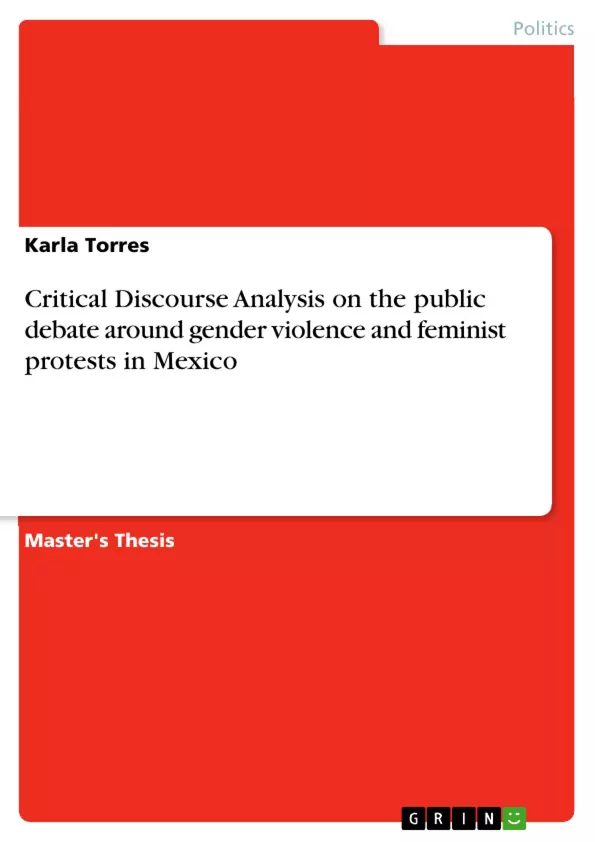This research aims to expose the discourse of government officials, the Catholic Church, feminists, and civil society around the feminist protests that have taken place in the context of high rates of violence in Mexico. Particularly, the aim is to understand if the discourse reinforces gender-based violence. The main methodology used was Critical Discourse Analysis to analyze the aforementioned positions, and specifically Fairclough's three-dimensional model. To this end, the situation in which the protests take place is first outlined in order to understand the context in which the discourses are produced. Through this analysis, it was found that the discourse strengthens gender-based violence, since it criminalizes the form of protest and delegitimizes the movement, putting the gender-based violence faced by women in the country in the background.
Inhaltsverzeichnis (Table of Contents)
- Introduction
- Methodology
- About gender-based violence
- Types of gender-based violence
- International figures on gender-based violence
- National figures on gender-based violence
- National laws and mechanisms on gender-based violence
- About the feminist protests
- Substantial components
- The right to protest
- The fourth feminist wave
- Feminist cyberactivism
- Happenings of the feminist protest
- Feminist protests in 2019
- Feminist protests in 2020
- Feminist protests in 2021
- Double indignation
- Substantial components
- Critical Discourse Analysis
- Fairclough's three-dimensional model of CDA
- Analysis categories
- Material Corpus
- Key Results
- Governmental Officials
- Catholic Church
- Feminists
- Civil Society
Zielsetzung und Themenschwerpunkte (Objectives and Key Themes)
This research aims to analyze the discourse surrounding feminist protests in Mexico, specifically examining how the discourse of government officials, the Catholic Church, feminists, and civil society addresses the issue of gender-based violence. The study investigates whether this discourse reinforces or undermines efforts to combat gender-based violence.
- The nature and prevalence of gender-based violence in Mexico
- The role of feminist protests in addressing gender-based violence
- The impact of public discourse on feminist protests
- The application of Critical Discourse Analysis to understand the complexities of the debate
- The role of different actors in shaping the public debate on gender-based violence
Zusammenfassung der Kapitel (Chapter Summaries)
The introductory chapter contextualizes the study, highlighting the alarming rates of gender-based violence in Mexico and the emergence of feminist protests as a response. It outlines the research objective and the methodology employed, namely Critical Discourse Analysis. The study focuses on the discourses of four key actors: government officials, the Catholic Church, feminists, and civil society.
Chapter 3 delves into the concept of gender-based violence, exploring its various forms, including structural, institutional, physical, and sexual violence. It provides an international and national overview of gender-based violence statistics, highlighting the severity of the issue in Mexico. The chapter then examines national laws and mechanisms in place to combat gender-based violence, providing a legal and political context for the study.
Chapter 4 investigates the feminist protests in Mexico, focusing on their substantial components, including the right to protest, the fourth feminist wave, and feminist cyberactivism. The chapter outlines key events and developments in the feminist movement, particularly from 2019 to 2021. It explores the concept of "double indignation" experienced by feminist protesters, stemming from both the persistence of violence and the perceived silencing of their demands.
Chapter 5 introduces the framework of Critical Discourse Analysis (CDA) and specifically focuses on Fairclough's three-dimensional model. It details the analysis categories and the material corpus used in the research. The chapter provides preliminary insights into the key results, including a brief overview of the discourse positions of each of the four actors: governmental officials, the Catholic Church, feminists, and civil society.
Schlüsselwörter (Keywords)
The primary focus of this research is on gender-based violence, feminicide, and feminist protests in Mexico. It employs Critical Discourse Analysis (CDA), specifically Fairclough's three-dimensional model, to analyze the public discourse surrounding these issues, examining the role of government officials, the Catholic Church, feminists, and civil society in shaping this discourse.
- Citar trabajo
- Karla Torres (Autor), 2022, Critical Discourse Analysis on the public debate around gender violence and feminist protests in Mexico, Múnich, GRIN Verlag, https://www.grin.com/document/1484266



